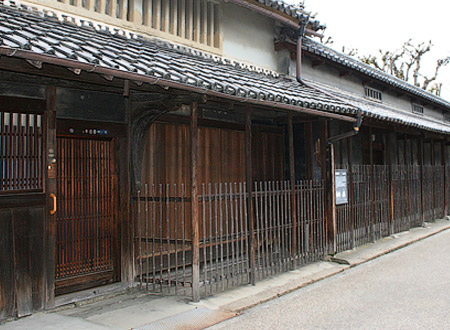1 A
low fence of latticework *koushi
格子, construction, used to prevent access to the areas which it enclosed.
In particular, in the Edo period, it was used to partition off the area
immediately in front of the living-room, kyoshitsubu 居室部, of urban
vernacular houses *machiya
町家. The aim was to prevent horses and dogs from getting close to the building,
and to enhance privacy in the vicinity of projecting bays of latticework,
degoushi 出格子. The area protected was usually a zone extending about
one metre out from the building. Already in use by the early 18c, they were
inevitably associated primarily with the larger, higher-status machiya
in which the business area *mise
店, was more of an office than an open shop. The komayose was built
in front of shops, including rice wholesalers, komeya 米屋, sake breweries
and soy manufacturers, shouyuya 醤油屋. There were two major types of
komayose: those which were simply barriers, made to be movable if desired,
and those intended to provide a framework to which horses might be tethered.
The latter was more permanent and thus the feet of the posts were driven
into the ground. Also referred to as komadome 駒留め and *inufusegi
犬防木.

Nakamura 中村 house (Osaka)
2 A palisade of wood or bamboo around a camp or fortification, designed
to keep away both horses and men. Used in the Sengoku period.
Also referred to as komayose yarai 駒寄せ矢来 and mase 馬棚.
3 In the vicinity of a stable, baba 馬場, a low fence provided
both for tethering horses and to keep them and people out of a given area.



